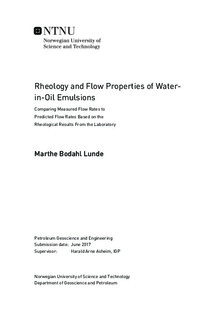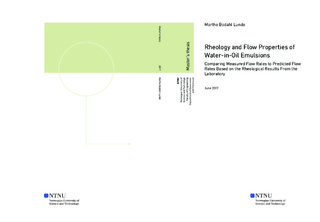| dc.description.abstract | Emulsions of oil and water can be formed throughout all processes during the production of petroleum. The properties of these may be very different from those of oil and water alone and knowledge about how different factors affect emulsions are therefore crucial. There are several rheological models which may describe such mixtures, but analyzing the precision of such models are rare in the literature. If the rheology models provide precise results they could be enabled when designing transport and separation systems.
In this thesis, engine oil emulsions have been made and measured to investigate the applicability of such models. Emulsions were made with varying water content, and several properties were measured; their temperature dependency, interfacial tension, droplet size and the concept of aging. A simple test facility was constructed to compare measured flow rates to flow rates estimated based on the rheological results from the laboratory. The average deviation between measured and estimated flow rates was 17.2% and the maximum 41.9%. | |

